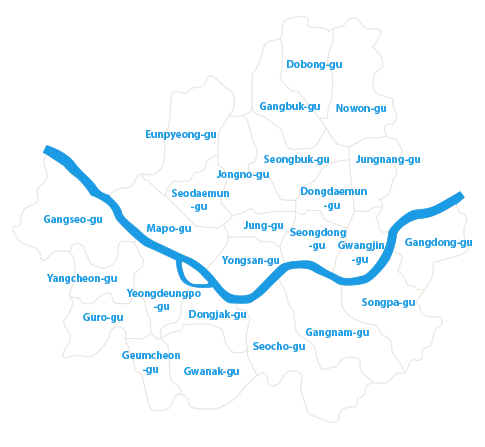Look around Seoul
Districts of Seoul
The Seoul city covers 0.28% of the entire peninsula (or 0.61% of South Korea), and spans an area of 30.30 km north-to-south and 34.78 km west-to-east. The Hangang (River) flows horizontally across Seoul, dividing the city into two sections lying north and south of the river.
There are 25 autonomous "gu" districts in Seoul, divided into 426 administrative "dong" sub-units in Seoul. Each "gu" is a basic local government unit that takes care of it's assigned affairs and autonomous duties. The "gu" provides administrative services that are closely related to the lives of citizens.

Statistic of Seoul's Population (2024)
 |
Total Population(Q3 2024)
9,605,419 |
 |
Senior Population (Q3 2024) (persons aged 65 and over) 1,803,910 |
 |
Adolescent Population (Q3 2024) (persons ages between 9 and 24) 1,331,694 |
 |
Old-age Dependency Ratio (Q3 2024)
26 |
 |
Migrants into Seoul (April 2024)
100,781 |
 |
Number of Foreigners (Q3 2024)
254,424 |
 |
Households (2023)
4,126,973 |
 |
Number of Births (July 2024)
3,484 |
 |
Monthly Number of Registered Marriages (July 2024)
3,709 |
 |
Number of Suicidal Deaths (2023)
2,163 |
Source: 통계로 본 서울 > 서울의 통계 > 통계정보 > 정보소통광장 (seoul.go.kr)
Status of Seoul
This indicates the principal data by selected sectors in Seoul.
http://opengov.seoul.go.kr/stat
A Day in Seoul (2022)
-

Births
117 babies -

Deaths
151 people
-

Marriages
98 couples
-

Divorces
36 couples
-

Movement of Population
4,568 people
-

Passports Issued
467 cases
-

Vehicle Increases
46 Vehicles
-

Public Transit - Bus Passengers
3,459,000 people
-

Public Transit - Subway Passengers
5,611,000 people
-

Death in Traffic Accidents
0.61 person
-

EMS Activity
1,701 cases
-

Fires
14.8 incidents
-

Electricity Consumed
133,668 MWh
-

Oil Consumed
92,000 barrel
-

Domestic Wastes Generated
9,493 tons (2018)
-

Building Permits Granted
28 buildings
-

Water Supply per Person
302 liters
-

Liquefied Natural Gas Consumed
11,905,000 m2
















